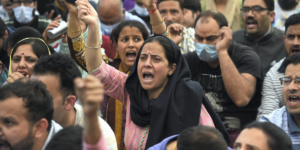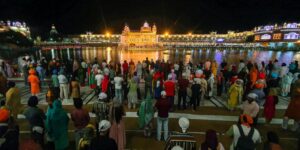Sandeep Pandey, Rajendran Narayanan
A ‘Restoration of Democracy’ march, part on feet and part on vehicles, was planned from Jammu to Srinagar between 26 November and 1 December, 2019 in Jammu and Kashmir after the decision of Government of India earlier on 5 August to abrogate Articles 370 and 35A and divide and downgrade the state into two Union Territories, J&K and Laddakh. When the march started on 26 November from Press Club, Jammu with over fifty people, the police stopped it just before it reached a main road and told us that we could not proceed on feet. They, however, allowed it to go on vehicles. The marchers then assembled at a nearby Gurudwara and about 30 of them went ahead in five vehicles. Prominent among the marchers were Sheikh Abdul Rehman, former Member of Parliament from J&K and two times Member of Legislative Assembly from Madhya Pradesh, Dr. Sunilam. The group reached Udhampur, its destination for the day, and distributed a pamphlet prepared for the march while taking out a procession though the market. The next morning, however, the police prevented the group from holding a press conference. The march then proceeded towards its destination for the second day, Ramban. Local political leader Amrit Varsha received the march with much fanfare. Slogans were raised for restoring the pre-5 August status and a press conference was immediately held. On 28 November morning distribution of pamphlets took place at the local bus stand and market. Small group discussions also took place with people while pamphlets were being distributed. However, after a public meeting held inside a hall during the day, the police arrived and threatened the journalists not to further cover the march and on the pretext that route ahead to Srinagar was closed due to land-slides asked the march to return to Jammu. The police vehicles followed the march and ensured that they crossed the Ramban district border on the way back to Jammu.
However, six marchers, including the two writers, decided to make an attempt to directly reach Srinagar by shared taxi and were successful on the second attempt on 29 November. In Srinagar, the group met Communist Party of India leader Ghulam Mohammad Mizrab in his village Poshpora in Shopian district and activists of J&K Coalition of Civil Society and Haq Insaf Party in Srinagar besides common citizens. The group also interacted with security personnel deployed at short distances from each other on stringent long duty hours for long stretches extending from several months to years.
Common sentiments expressed by people ranged from disappointment to anger at the way the Union Government has handled the situation. G.M. Mizrab said that earlier there were three kinds of people in J&K, one who had accepted being part of India, second who aspired for independence from India and Pakistan both and third who looked towards Pakistan with some hope, although the latter two segments had realised over a period of time that their dreams were not practical and had shrunk in size. For example, the total number of militants presently in J&K, according to government’s own figures, is not more than 300, for whom 8 lakhs security personnel have been deployed and the government incurs an extra expenditure, other than salaries and upkeep, of Rs 3 crore daily. Most Kashmiri families now have some connection with India, either their children are studying in some educational institutions or they have business interests elsewhere in India. But after the 5 August decision of the government, when even the most pro-India leader Dr. Farooq Abdullah was put under house arrest, majority in Kashmir have now turned against India. Mizrab says that even though he would prefer to be with India, he has been deeply hurt by the decision as he thinks it is taking away his identity in a way. A college teacher put it more succinctly: Articles 370 and 35A were like nikah-nama, document of marriage, between India and J&K, and the Indian government by abrogating these Articles has annulled the marriage. The link between India and J&K has been severed and the alienation is now complete. Another college teacher said previously they were not so conscious of Indians coming to J&K but now they view them with suspicion. It is what the British rule was for India. Khurram Parvez of JKCCS informed that about 3.5 to 5 lakh migrant labourers have also been sent back to India before 5 August just like the tourists, whose departure was publicised, and it may not be a surprise that after some time Kashmiris may be blamed for this just like they are blamed for driving out the Kashmiri Pandits, even though they were evacuated then, initially only for several months, on the pretext of some planned action against militants, both of which have now prolonged. The group of marchers also saw vacant houses belonging to Kashmiri Pandits on the border of Shopian district and Pulwama, keeping the option for them to return open, in addition to a colony established for Hindu government employees here. It doesn’t appear that there is any problem in common Kashmiris belonging to any religion living together as they emphasise that their culture is Kashmiriyat and the variety of Islam practised here is Sufi.
The economic life seems to be limping back to normalcy from external appearance, with business and economic activity going on for several hours during the day, but the fact is that the four month long clampdown has broken the back of the economy which was further compounded by bad weather. The apple industry suffered the worst. The producers could not meet the demands of buyers due to lack of labourers and restriction in transportation and trees have been damaged due to early snow which will take about a decade to re-grow. It is being claimed that Jammu region, especially the larger Hindu population is happy with government’s decision, but the fact is that economy of this region is tied with Kashmir and has also suffered badly. People in Kashmir now want to bypass Jammu and want to do business with other regions of the country.
When one of the marchers Amit Maurya took photograph of an empty classroom in a school in Haval on 30 November, 2019, the teachers present panicked. They would not let him leave until he deleted the photograph from his mobile phone. In spite of the claims being made by the Home Minister, the fact is that except for the Board examinations, the questions papers were taken by teachers to homes of students of all other classes and answers brought back to the school. The parents of children are forced to engage the same teachers at home for tuition classes at monthly charges upto Rs. 5,000 for a child of class VI or VII.
It is not clear when the economy or education will return to normalcy but the most serious damage that the government has done is to politics. There is no sign of revival of political process. While the Bhartiya Janata Party has realised the political agenda of Rashtriya Swayamsewak Sangh in J&K, it is preventing other Parties from carrying out their activities. There is a ban on political activity, especially related to Articles 370 and 35A. Government employees have been made to sign an agreement to be part of one of the two Union Territories. The people who were arrested are being released after 10-15 community members are made to sign bonds guaranteeing that the person being released will not take part in any activity opposing the abrogation of Articles 370 and 35A. The government doesn’t want any other voice than its own. Most newspapers are carrying government advertisements or reporting government and apolitical events. The media is totally censored. The bureaucracy and security establishment is dominating the politics. There doesn’t seem to be any hope for restoration of democracy yet. Senior activist of JKCCS Pervez Imroz asks how can there be democracy in a situation of occupation, either before 5 August or after that?
(Sandeep is a social-political activist and Rajendran teaches at Azmi Premji Univeristy.)




